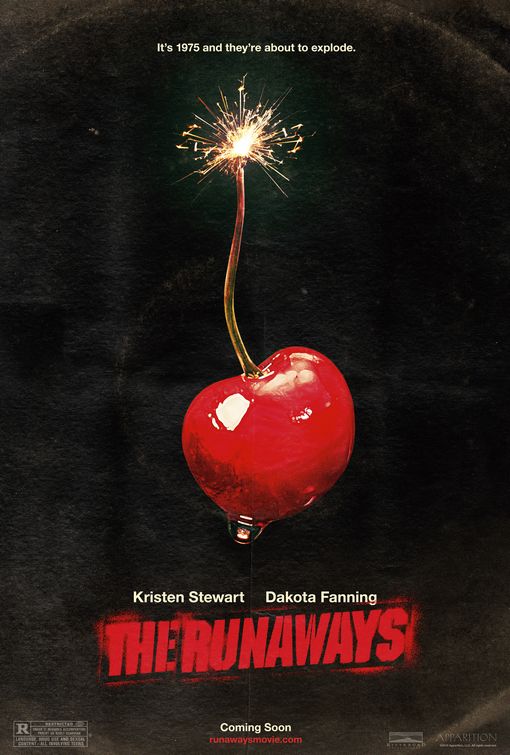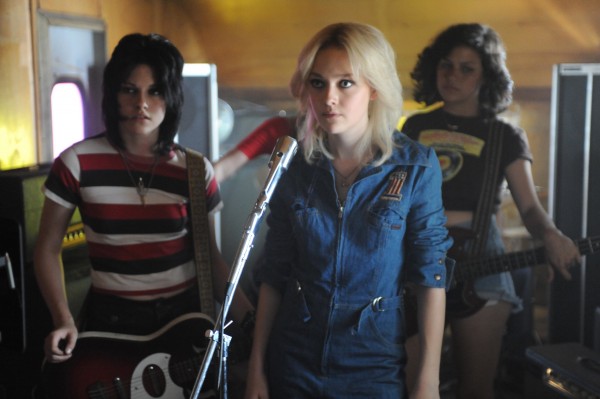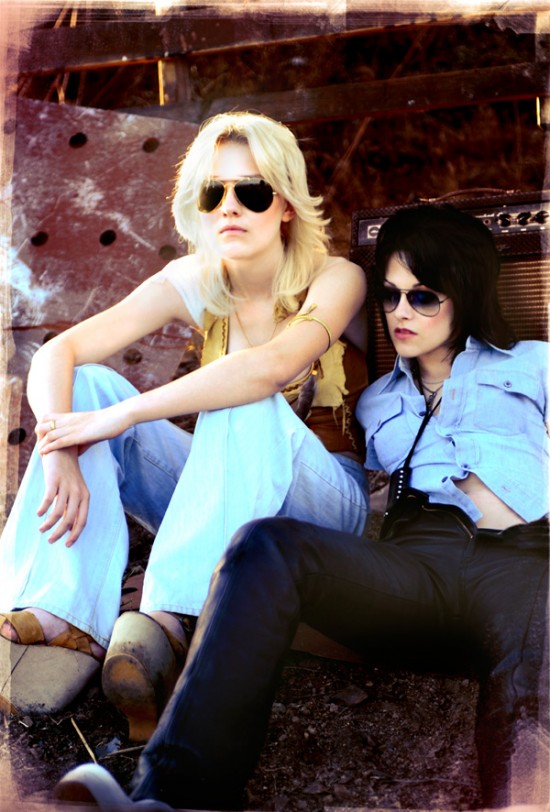Wed 17 Mar 2010
The Girls Are Alright
Posted by Ethan under Film Review, NYC Film Critic
Comments Off on The Girls Are Alright
The Runaways
Directed by Floria Sigismondi
Starring Kristen Stewart, Dakota Fanning and Michael Shannon
***
Most rock-star biopics tend to focus on the larger-than-life personalities of their subjects rather than the places and times from which they emerge. That’s not to say that movies like Ray and Walk the Line don’t pay attention to period details; all the era-appropriate hairstyles, fashions, cars and even magazine covers are always carefully placed in the frame and every now and then a character will either witness or make a comment about some major historical event to convince the audience that, yes, this really is 1963 or 1972.
Despite the filmmakers’ efforts though, these recreations of the not-too-distant past often comes across as artificial, as if the characters are living on a stage dressed up to look like the ’50s/’60s/’70s/’80s. That’s because effectively capturing the look and feel of an era requires something more than just the right model of toaster or a specific brand of jeans. It’s about establishing the right mood, the right vibe, something that a lot of these films simply don’t have time for because they have so much ground to cover in such a limited time.
Floria Sigismondi’s The Runaways stands apart from much of its musical biopic brethren for several reasons, not the least of which is because it’s about its era–the mid ’70s–first and its titular band second. Of course, Sigismondi has an advantage that other directors that have tackled this genre often don’t and that’s the short lifespan of the group she’s chosen to depict. Where Ray Charles and Johnnie Cash enjoyed careers that lasted for decades, The Runaways burned brightly for roughly two years and then fell apart, which allows the director to really zero in on a specific period instead of having to account for multiple years in her subjects’ lives. Even so, Sigismondi deserves credit for evoking the ’70s so completely; there’s a rough-edged authenticity to this film that’s missing from so many other antiseptic rock ‘n’ roll tales.
The ballad of The Runaways unfolded in California from 1975 to 1977, an era defined by equal parts rebellion, hedonism, confusion and sheer raw anger. It was also a time when women had made enormous strides towards equality, yet still found themselves blocked from pursuing certain career avenues like, say, rock music. According to the movie’s point-of-view, it was that specific confluence of factors that resulted in the birth of The Runaways, a group of five teenage girls who were supposed to be the new saviors of rock. The band’s members included raven-haired guitarist Joan Jett (played by Twilight‘s Kristen Stewart) and 15-year-old Bardot-esque singer Cherie Currie (Dakota Fanning, all grown up…almost), both of whom saw music not just as a hobby but as a kind of higher calling–they didn’t just want to do it, they had to do it. Under the hand of flamboyant manager Kim Fowley (Michael Shannon), The Runaways played their hearts out and lived the rock star life as fully as any male rocker. During their brief career, they enjoyed a hit single (“Cherry Bomb”) and a few raucous tours (including one in Japan) before breaking up due to the same things that have dissolved every rock band from The Beatles to Guns N’ Roses–namely group in-fighting and drug abuse.
From a narrative perspective, there’s nothing particularly unique about The Runaways. Sigismondi’s screenply follows the same rise-and-fall arc that’s applied to every musical biopic and even makes room for such genre clichés as the “impromptu” creation of iconic songs and the requisite storming-out-of-the-recording-studio scene. It’s also a shame that the movie declines to follow two of its most interesting plot threads, specifically Currie and Jett’s off-stage relationship (the movie includes one dimly-lit sex scene between the two but then never refers to their apparent attraction again) and the irony that this group of kick-ass female rockers was formed and ultimately controlled by a man.
Again, what distinguishes the film is its texture and sense of place. Taking her visual cues from Oliver Stone’s The Doors as well as Catherine Hardwicke’s Thirteen, Sigismondi gives the movie a nervous energy that fits both the time period and the characters’ state of mind. At times, she does go too far; some of the concert sequences, for example, go overboard on the phantasmagorical imagery. She also would benefit from more experience working with actors; while Fanning is quite good as Currie, Stewart wears one expression throughout the whole movie and Shannon is allowed to rant and rave like he’s still playing his brain-addled character from Revolutionary Road. (This may be an accurate depiction of Fowler, but Shannon’s outsized performance verges into Saturday Night Live-style caricature when compared with the rest of the cast.) But where so many musical biopics are content to boil down their subject’s life to a greatest-hits format, The Runaways wants the audience to really understand where this group came from and why, for a brief moment in time at least, they mattered.
The Runaways opens in limited release on Friday and expands to more markets on April 9.




No Responses to “ The Girls Are Alright ”
Sorry, comments for this entry are closed at this time.